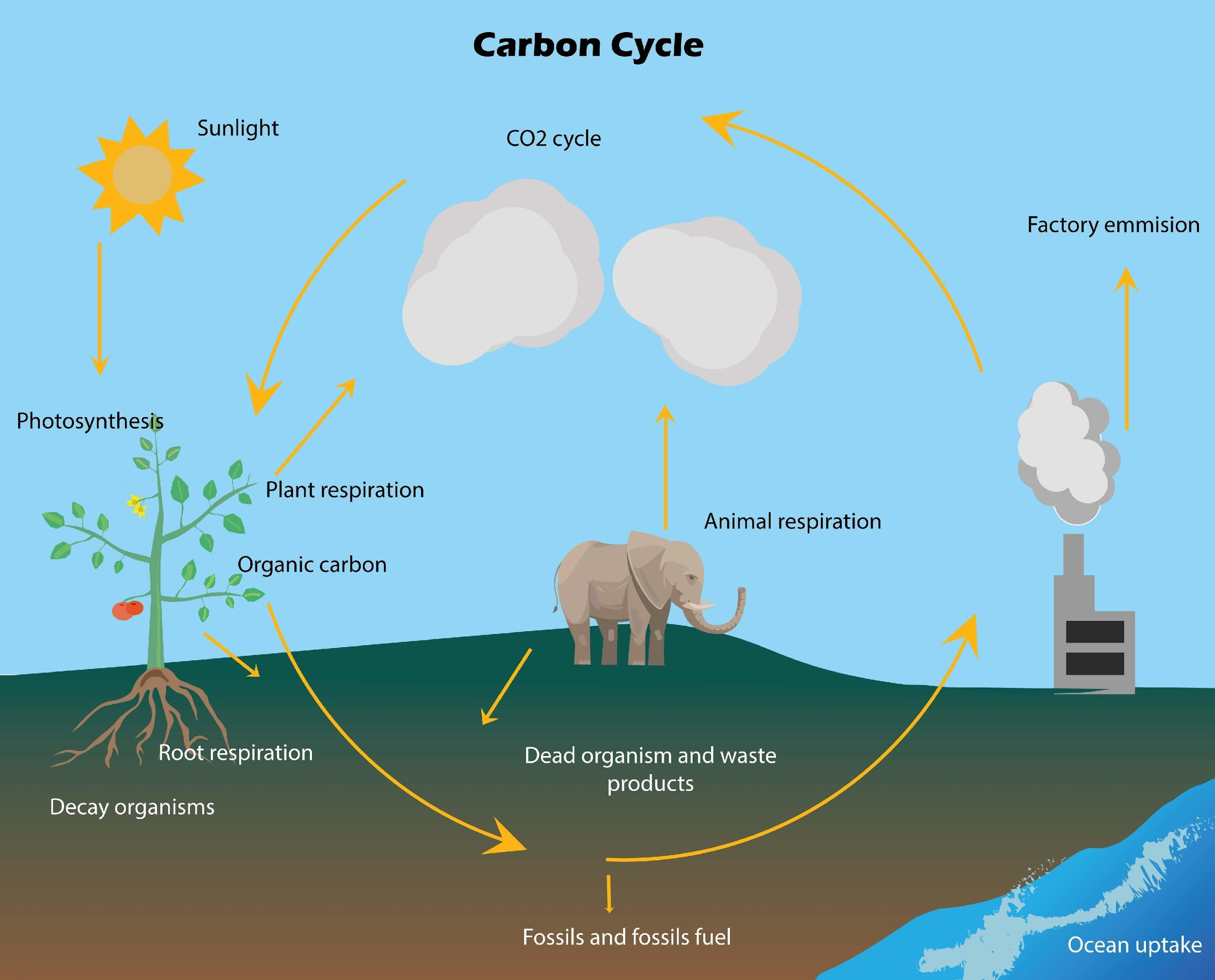
Which step is not involved in the carbon cycle?
(a)Photosynthesis
(b)Transpiration
(c)Respiration
(d)Burning of fossil fuels
Answer
583.5k+ views
Hint: The continuous formation, breakdown and usage of carbon and its molecules in the atmosphere, biosphere, pedosphere, hydrosphere and lithosphere of the earth is the carbon cycle.
Complete answer:
Carbon constitutes about 49% of the dry weight of organisms. It is estimated that 71% of the global carbon is found in the dissolved form in oceans. The reservoir of carbon is found in the hydrosphere(oceans), lithosphere (as deposits of fossil fuels) and in the atmosphere (as carbon dioxide). In oceans, it remains stored as bicarbonate as limestone and marble rocks. The cyclic pathway of carbon has the following steps:
Photosynthesis: The carbon enters the biotic components of the ecosystem through the green plants, photosynthetic bacteria and cyanobacteria in the terrestrial ecosystem and through phytoplanktons and hydrophytes in the aquatic ecosystems. These are called producers and carry out photosynthesis by taking in the atmospheric carbon dioxide and making carbohydrates and oxygen.
Respiration: The carbon fixed by the producers enters the food chain and is consumed by different living organisms. Carbon dioxide is released into the atmosphere by respiration of producers and consumers.
Decomposition: The decomposers breakdown the larger organic compounds into simpler ones and then into inorganic molecules. In this process, a small amount of carbon dioxide is returned back to the atmosphere during the enzyme-catalyzed breakdown of dead matter by decomposers.
Combustion: Burning of fossil fuels in the automobiles and machinery to produce energy, burning of wood, organic debris also releases carbon dioxide, volcanic eruptions and hot springs also release carbon dioxide into the atmosphere.
In the above-discussed carbon cycle, there is no movement of water involved in the plant structures. Transpiration is the loss of water from the living tissue of the aerial part of the plant in the form of water vapour.

Thus, in the carbon cycle ‘transpiration' is not involved.
Note: Increase in the carbon dioxide levels in the atmosphere can lead to climate change in the upcoming future years. This is known as global warming and is responsible for the unwanted increase of temperature on earth leading to the melting of glaciers that may result in a disaster.
Complete answer:
Carbon constitutes about 49% of the dry weight of organisms. It is estimated that 71% of the global carbon is found in the dissolved form in oceans. The reservoir of carbon is found in the hydrosphere(oceans), lithosphere (as deposits of fossil fuels) and in the atmosphere (as carbon dioxide). In oceans, it remains stored as bicarbonate as limestone and marble rocks. The cyclic pathway of carbon has the following steps:
Photosynthesis: The carbon enters the biotic components of the ecosystem through the green plants, photosynthetic bacteria and cyanobacteria in the terrestrial ecosystem and through phytoplanktons and hydrophytes in the aquatic ecosystems. These are called producers and carry out photosynthesis by taking in the atmospheric carbon dioxide and making carbohydrates and oxygen.
Respiration: The carbon fixed by the producers enters the food chain and is consumed by different living organisms. Carbon dioxide is released into the atmosphere by respiration of producers and consumers.
Decomposition: The decomposers breakdown the larger organic compounds into simpler ones and then into inorganic molecules. In this process, a small amount of carbon dioxide is returned back to the atmosphere during the enzyme-catalyzed breakdown of dead matter by decomposers.
Combustion: Burning of fossil fuels in the automobiles and machinery to produce energy, burning of wood, organic debris also releases carbon dioxide, volcanic eruptions and hot springs also release carbon dioxide into the atmosphere.
In the above-discussed carbon cycle, there is no movement of water involved in the plant structures. Transpiration is the loss of water from the living tissue of the aerial part of the plant in the form of water vapour.

Thus, in the carbon cycle ‘transpiration' is not involved.
Note: Increase in the carbon dioxide levels in the atmosphere can lead to climate change in the upcoming future years. This is known as global warming and is responsible for the unwanted increase of temperature on earth leading to the melting of glaciers that may result in a disaster.
Recently Updated Pages
Why are manures considered better than fertilizers class 11 biology CBSE

Find the coordinates of the midpoint of the line segment class 11 maths CBSE

Distinguish between static friction limiting friction class 11 physics CBSE

The Chairman of the constituent Assembly was A Jawaharlal class 11 social science CBSE

The first National Commission on Labour NCL submitted class 11 social science CBSE

Number of all subshell of n + l 7 is A 4 B 5 C 6 D class 11 chemistry CBSE

Trending doubts
Differentiate between an exothermic and an endothermic class 11 chemistry CBSE

10 examples of friction in our daily life

One Metric ton is equal to kg A 10000 B 1000 C 100 class 11 physics CBSE

Difference Between Prokaryotic Cells and Eukaryotic Cells

1 Quintal is equal to a 110 kg b 10 kg c 100kg d 1000 class 11 physics CBSE

State the laws of reflection of light




